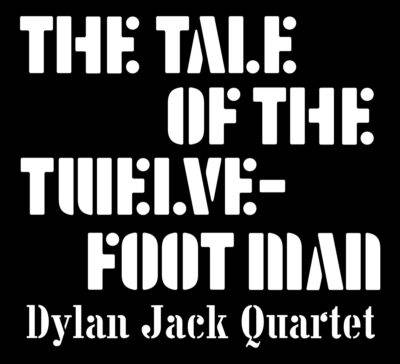Dylan Jack Quartet The Tale of the Twelve-Foot Man
Dylan Jack Quartet
The Tale of the Twelve-Foot Man
Creative Nation Music
Last October on these pages we covered the inventive set of covers from the duo, guitarist Eric Hofbrauer and drummer Dylan Jack, entitled Remains of Echoes which has them addressing not only jazz but rock. Any group that puts Miles and Ornette Coleman on the same album as The Police, Jimi Hendrix, and Jackson Browne is not only far ranging but highly imaginative too. The answer to what they might do with their own original material is here now with the Dylan Jack Quartet, rounded out with master trumpeter Jerry Sabatini and bassist Anthony Leva. This is the quartet follow-up to 2017’s Diagrams with Sabatini as the new featured horn.
These are Jack’s compositions and he comments accordingly, “The Twelve-Foot Man…does not necessarily represent a positive or negative figure,” notes Jack, “Instead, it represents a challenge that we individually face; a tall figure looming over our shoulder as we go about our lives.” The Twelve-Foot Man referred to in the title might be termed conscience, or subjectivity, that looming and unshakeable presence of the self: sometimes a hindrance, sometimes simply an existential fact. “The music is not easy,” Jack says, “but Jerry came in and gave it the respect it deserved. He has a great sound and is a master with mutes. I let him make his own decisions in terms of sounds — I wanted him to make the music as personal to him as he could. That’s the great thing with this band: although it’s under my name it’s everyone’s band. Everyone has a voice.”
The four pieces collectively clock in at under 40 minutes so it’s a quick listen, especially for a jazz album. We take these descriptions from David Adler’s copious oner notes, because as Jack indicated, “the music is not easy.” The opener “Gauchais Reaction,”, concerns the psychological phenomenon of subconscious mimicry, which in jazz and improvised music connotes band chemistry on the deepest level. The piece opens with drums, Jack musing abstractly before the band enters and Leva establishes a powerful presence with his bow. Sabatini’s trumpet is muted, Hofbauer’s guitar closely mic’ed to the extent one can hear his fingers sliding over the frets. When Leva switches to plucking, the piece begins to groove, at a floating yet perceptible tempo. Sabatini and Hofbauer alternate in the spotlight, with short composed breaks signaling unexpected transitions to duo, trio and full quartet interplay. Sabatini’s use of mutes and his short bursts will remind of Miles, except that he is particularly adept in the low ranges of the horn.
Parts I & II of the title track evoke the Man’s presence in differing ways, but they share a reliance on darting and intricate unison melodies and driving rhythms, with a certain open-ended swing energy in the solos. The meters shift frequently here in a seamless way, with melodies and figures changing measure to measure from 12/16 to 9/16 to 7/16, or from 7/4 to 5/8 to 6/4. “My use of mixed meter is definitely inspired by phrasing,” Jack explains. “At first I usually write phrases without bar lines and sometimes no strict rhythm or note values, just stemless noteheads, and a ‘trademark’ of mine is using bars of 3/4 or 2/4 at the end of phrases. Often a 4/4 bar to end a phrase leaves too much space to my liking. Like birds chirping or a train riding by, there is no strict meter to life, and I like to write with that level of freedom.” Part II, at first demonstrates Hofbauer and Jack’s rhythmic like-mindedness with several minutes of duo improvisation building to a driving groove with Sabatini at the front of the sound. Jack takes an inventive drum solo midway through before Sabatini rejoins with his robust tone and carefully places echo effects. We hear individual statements from Leva and Hofbrauer as well in this rather mysterious, meandering piece. They know where they are going. We, as listeners don’t have that advantage and therein lies the joy of unpredictability. These pieces, especially Part 1, owe more to free jazz, bringing Ornette Coleman and Don Cherry to mind. In this case, those dialogues are mostly between Sabatini and Hofbrauer.
The final track, “The Epitaph,” is self-explanatory. The Twelve-foot Man is no longer here. The melody is derived from the Seikilos Epitaph, the oldest known piece of notated music, an ancient Greek melody carved into a cylindrical stele in the first or second century A.D. This melody is transformed with bold harmonies and improvisation from the ensemble. Throughout the piece, the ensemble seems to embody the words of the original Epitaph, translated from Greek to mean “While you live, shine. Have no grief at all. Life only exists for a short while. And time demands his due.” It ends with short cries and slight pattering of drums, essentially as a whimper rather than a climax. Throughout Tony Leva’s bass playing is quite interesting as he creates a variety of sounds using the bow, plucking, or in this piece playing a sinter, a low-pitched, 3-string skin covered lute associated with Morocco and Algeria.
The interplay of these four players is astounding across these challenging pieces that create varying moods, not only through the music but through a judicious use of space, echo effects, and accents, sometimes when you least expect them.
- Jim Hynes
More About the Artist: (We provided background on both Jack and Hofbrauer in our Remains of Echoes review but we reprise Jack here)
Dylan Jack is a percussionist, composer and improviser participating in multiple genres within the Boston music scene. As a performer, Jack divides his attention between playing as a sideman with some of the city’s top improvisors including Charlie Kohlhase, Jeb Bishop, Bill Lowe, Eric Hofbauer, and leading his main creative outlet, the Dylan Jack Quartet.
In 2016, Jack launched the Dylan Jack Quartet, a creative music ensemble focusing on combining intricately composed segments that utilize odd meters and phrasing with plenty of space for improvisations with emphasis on each player’s individual voice and in-depth group collaborations. Jack released his first record with the quartet, Diagrams (CNM 031), in 2017 as well as a duo release with Hofbauer that we mentioned, Remains of Echoes (CNM 036) to favorable reviews in the jazz community.
Jack is also an in demand private percussion instructor on the north shore of Massachusetts as well as an Affiliated Faculty member of Emerson College where he teaches The History of Jazz. Jack received his bachelor’s degree in music from the McNally Smith College of Music in Saint Paul, Minnesota, and holds a Masters of Music in Modern American Music from the Longy School of Music of Bard College.
Discover more from Making A Scene!
Subscribe to get the latest posts sent to your email.















































